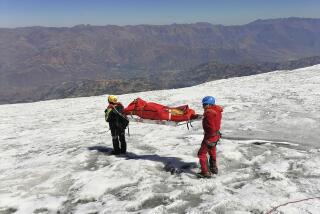Mysterious Man in the Glacier: Clues Provide Solution
ZERMATT, Switzerland — Ski teacher Annemarie Julen-Lehner found the first bones. They were on the side of the Theodul Glacier, which was softening in the hot sun.
It wasn’t the first time that the glacier was reluctantly releasing a victim from its frozen depths of blue and green ice.
Lichenbretter , or “corpse slab,” is the local Swiss German dialect name for the huge mass of ice winding around the Matterhorn mountain.
For centuries it was a treacherous crossing at 10,880 feet between Switzerland and Italy for those brave enough and too pressed for time to spend weeks traveling through the valley.
Deep Crevasses
Merchants and messengers in a hurry would use it, as would soldiers and mercenaries who were willing to risk the deep crevasses concealed by a deceptively thin layer of snow.
Usually the glacier would give up entire bodies perfectly preserved by the ice, making identification a fairly simple matter.
But this time was different, because Julen-Lehner at first found only bones.
Collecting some of them, she took them down to the village and called her brother, Peter Lehner, who happens to be a biologist in Richterwil close to Zurich.
Man, Animal Bones
“They were the bones of a human being, a man, and of an animal, which was probably a mule,” Lehner said. “The man and the animal had obviously been exposed at one time but were then taken in by the glacier once again.”
Local records indeed show that the Theodul Glacier grew enormously at the end of the 16th Century, in what was known as a “a little Ice Age.”
Almost certainly, the preserved bodies of a man and mule had emerged during a previous retreat of the ice and decomposed in the air and sun. But the bones that were left were then covered again when the glacier advanced anew.
Glaciers are masses of ice and snow that accumulate in regions where snow falls at a greater rate than it melts.
Glacier Movement
They can be hundreds of feet deep and move down valleys and mountainsides, sometimes as fast as several feet a year, sometimes only inches.
Victims preserved in the moving ice are expelled after tens of years--or in this case even centuries--when the glacier gets down to lower altitudes where the ice melts begins to shrink them. Most thawing occurs at the bottom and sides, but sometimes a glacier will simply break off on reaching the edge of a cliff.
So who was this mystery man of the glacier? When did he die and why had he tried to make the crossing?
A search through Zermatt chronicles showed that a certain Anton Fux disappeared on the glacier in 1584. His body has never been found.
Coins Discovered
That wasn’t the right man, however, as Peter and Annemarie Lehner discovered while scouring the glacier.
They found pieces of clothing. But more importantly they found 35 small bronze and copper coins. Three of them were Swiss and bore the picture of Bishop Hildrebrand I of Riedmatten. The others had been minted in northern Italy.
The oldest coin was dated 1585, so the bones could not be those of Anton Fux, who had disappeared a year earlier.
So the initial conclusion was that the bones were those of a merchant and his mule who had fallen into the depths of the glacier while on the way from Italy to Switzerland. But Peter Lehner had a nagging doubt.
Skull Found
“Why would a presumably wealthy merchant have been carrying only the equivalent in those days of loose change?” he wondered.
In September, he returned to the glacier and found the man’s skull, complete with brown hair and parts of the brain--”just like a coconut at first glance,” he said.
Close by were a fencing sword, a flint musket and two silver coins dated 1588. The coins showed the face of Philipp II, the Habsburg ruler at that time in Spain and northern Italy.
More to Read
Sign up for Essential California
The most important California stories and recommendations in your inbox every morning.
You may occasionally receive promotional content from the Los Angeles Times.










